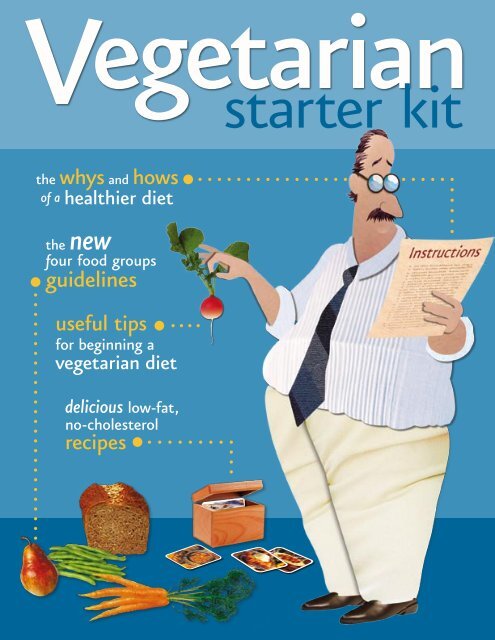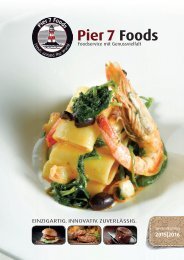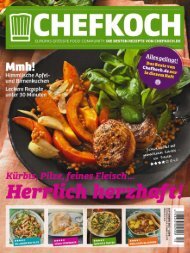testff
testfff
testfff
Create successful ePaper yourself
Turn your PDF publications into a flip-book with our unique Google optimized e-Paper software.
the whys and hows<br />
of a healthier diet<br />
the new<br />
four food groups<br />
guidelines<br />
useful tips<br />
for beginning a<br />
vegetarian diet<br />
delicious low-fat,<br />
no-cholesterol<br />
recipes<br />
starter kit<br />
PCRM 1
Inside this Kit<br />
the whys and hows<br />
Vegetarian Foods .................2<br />
The Protein Myth ................4<br />
Calcium in<br />
Plant-Based Diets .................6<br />
What about Milk? ................7<br />
Achieving and<br />
Maintaining<br />
a Healthy Weight ..............10<br />
Vegetarian Diets<br />
for Pregnancy ..................... 11<br />
Vegetarian Diets<br />
for Children .........................12<br />
new four food groups<br />
Guidelines ..............................8<br />
tips for vegetarian diets<br />
The 3-Step Way to<br />
Go Vegetarian .......................3<br />
Tips for Making<br />
the Switch .............................4<br />
Cooking without Eggs ........5<br />
Dairy-Free Dining .................7<br />
The Veganizer .....................10<br />
Meal Planning<br />
for Children ......................... 13<br />
low-fat recipes<br />
Recipes for Health .............14<br />
2 VEGETARIAN STARTER KIT<br />
vegetarian<br />
foods<br />
Powerful Tools for Health<br />
Avegetarian menu is a powerful and pleasurable way to achieve good health.<br />
The vegetarian eating pattern is based on a wide variety of foods that are<br />
satisfying, delicious, and healthful.<br />
Vegetarians avoid meat, fish, and poultry. Those who include dairy products and<br />
eggs in their diets are called lacto-ovo vegetarians. Vegans (pure vegetarians) eat no<br />
meat, fish, poultry, eggs, or dairy products. While there is a considerable advantage<br />
to a lacto-ovo vegetarian pattern, vegan diets are the healthiest of all, reducing risk<br />
of a broad range of health concerns.<br />
a healthy heart<br />
Vegetarians have much lower cholesterol levels than meat-eaters, and heart disease<br />
is less common in vegetarians. The reasons are not hard to find. Vegetarian meals<br />
are typically low in saturated fat and usually contain little or no cholesterol. Since<br />
cholesterol is found only in animal products such as meat, dairy, and eggs, vegans<br />
consume a cholesterol-free diet.<br />
The type of protein in a vegetarian diet may be another important advantage. Many<br />
studies show that replacing animal protein with plant protein lowers blood cholesterol<br />
levels—even if the amount and type of fat in the diet stays the same. Those studies<br />
show that a low-fat, vegetarian diet has a clear advantage over other diets.<br />
lower blood pressure<br />
An impressive number of studies, dating back to the early 1920s, show that vegetarians<br />
have lower blood pressure than non-vegetarians. In fact, some studies have<br />
shown that adding meat to a vegetarian diet raises blood pressure levels rapidly and<br />
significantly. The effects of a vegetarian diet occur in addition to the benefits of reducing<br />
the sodium content of the diet. When patients with high blood pressure begin a<br />
vegetarian diet, many are able to eliminate the need for medication.<br />
controlling diabetes<br />
The latest studies on diabetes show that a vegetarian diet high in complex carbohydrates<br />
and fiber (which are found only in plant foods) and low in fat is the best<br />
dietary prescription for controlling diabetes. A diet based on vegetables, legumes,<br />
fruits, and whole grains, which is also low in fat and sugar, can lower blood sugar levels<br />
and often reduce or even eliminate the need for medication. Since individuals with<br />
diabetes are at high risk for heart disease, avoiding fat and cholesterol is important,<br />
and a vegetarian diet is the best way to do that.<br />
cancer prevention<br />
A vegetarian diet helps prevent cancer. Studies of vegetarians show that death<br />
rates from cancer are only about one-half to three-quarters of those of the general<br />
population.<br />
Breast cancer rates are dramatically lower in countries where diets are typically
plant-based. When people from those<br />
countries adopt a Western, meat-based<br />
diet, their rates of breast cancer soar. Vegetarians<br />
also have significantly lower rates<br />
of colon cancer than meat-eaters. Colon<br />
cancer is more closely associated with<br />
meat consumption than any other dietary<br />
factor.<br />
Why do vegetarian diets help protect<br />
against cancer? First, they are lower in<br />
fat and higher in fiber than meat-based<br />
diets. But other factors are important,<br />
too. Plants contain other cancer-fighting<br />
substances called phytochemicals. For example,<br />
vegetarians usually consume more<br />
of the plant pigments beta-carotene and<br />
lycopene. This might help to explain why<br />
they have less lung and prostate cancer.<br />
Also, some studies have suggested that diets<br />
that avoid dairy products may reduce<br />
the risk of prostate and ovarian cancer.<br />
Some of the anti-cancer aspects of a<br />
vegetarian diet cannot yet be explained.<br />
For example, researchers are not quite<br />
sure why vegetarians have more of certain<br />
If you are making the switch<br />
to a vegetarian diet for its health<br />
benefits, you’ll be pleased to find<br />
that there is a wonderful additional<br />
benefit to vegetarian eating: it’s<br />
a delicious and fun way to explore<br />
new foods. A vegetarian meal can<br />
be as familiar as spaghetti with<br />
marinara sauce, as comforting as<br />
a bowl of rich, potato soup, or<br />
as exotic as Grilled Polenta with<br />
Portabella Mushrooms (see recipe<br />
on page 15).<br />
The switch to a vegetarian diet<br />
is easier than you might think.<br />
Most people, whether vegetarians<br />
or meat-eaters, typically use<br />
a limited variety of recipes; the<br />
average family eats only eight or<br />
nine different dinners repeatedly.<br />
You can use a simple, three-step<br />
method to come up with nine<br />
vegetarian dinner menus that you<br />
enjoy and can prepare easily.<br />
white blood cells, called “natural killer<br />
cells,” which are able to seek out and destroy<br />
cancer cells.<br />
the calcium connection<br />
Vegetarians are less likely to form either<br />
kidney stones or gallstones. In addition,<br />
vegetarians may also be at lower risk for<br />
osteoporosis because they eat little or no<br />
animal protein. A high intake of animal<br />
protein encourages the loss of calcium<br />
from the bones. Replacing animal products<br />
with plant foods reduces the amount<br />
of calcium lost. This may help to explain<br />
why people who live in countries where<br />
the diet is typically plant-based have little<br />
osteoporosis, even when calcium intake<br />
is lower than that in dairy-consuming<br />
countries.<br />
planning vegetarian diets<br />
It’s easy to plan vegetarian diets that<br />
meet all your nutrient needs. Grains,<br />
beans, and vegetables are rich in protein<br />
The Three-Step Way to Go Vegetarian<br />
First, think of three vegetarian meals that you already<br />
enjoy. Common ones are tofu and vegetable<br />
stir-fry, vegetable stew, or pasta primavera.<br />
Second, think of three recipes<br />
that you prepare regularly<br />
that can easily be adapted to<br />
a vegetarian menu. For example,<br />
a favorite chili recipe can<br />
be made with all of the same<br />
ingredients; just replace the<br />
meat with beans or texturized<br />
vegetable protein. Enjoy<br />
bean burritos (using canned<br />
vegetarian refried beans) instead<br />
of beef burritos, veggie<br />
burgers instead of hamburgers,<br />
and grilled eggplant and<br />
roasted red peppers instead of<br />
grilled chicken in sandwiches.<br />
Many soups, stews, and casseroles<br />
also can be made into<br />
vegetarian dishes with a few<br />
simple changes.<br />
and iron. Green leafy vegetables, beans,<br />
lentils, tofu, and nuts are excellent sources<br />
of calcium, as are enriched soymilk and<br />
fortified juices.<br />
Vitamin D is normally made in the<br />
body when sun shines on the skin. People<br />
who are dark-skinned or live at northern<br />
latitudes have some difficulty producing<br />
vitamin D year-round. Vitamin D can<br />
easily be obtained from fortified foods.<br />
Some sources are commercial breakfast<br />
cereals, soymilk, other supplemental<br />
products, and multivitamins.<br />
Regular intake of vitamin B12 is important.<br />
Good sources include all common<br />
multiple vitamins (including vegetarian<br />
vitamins), fortified cereals, some brands<br />
of nutritional yeast, and fortified soymilk.<br />
It is especially important for pregnant<br />
women and breast-feeding mothers to get<br />
enough vitamin B12. When reading food<br />
labels, look for the word cyanocobalamin<br />
in the ingredient list. This is the form of<br />
vitamin B12 that is best absorbed.<br />
Third, check out some vegetarian<br />
cookbooks from the<br />
library and experiment with<br />
the recipes for a week or<br />
so until you find three new<br />
recipes that are delicious and<br />
easy to make. Just like that,<br />
with minimal changes to your<br />
menus, you will have nine<br />
vegetarian dinners.<br />
After that, coming up<br />
with vegetarian options<br />
for breakfast and lunch<br />
is easy. Try muffins with<br />
fruit spread, cholesterolfree<br />
French toast, or cereal<br />
for breakfasts. Sandwiches<br />
with spreads like hummus<br />
or white bean pâté with<br />
lemon and garlic, pasta<br />
salads, or dinner leftovers<br />
make great lunches.<br />
PCRM 3
The Protein Mythpoof!<br />
I<br />
n the past, some people believed one could never get too<br />
much protein. In the early 1900s, Americans were told to<br />
eat well over 100 grams of protein a day. And as recently<br />
as the 1950s, health-conscious people were encouraged to boost<br />
their protein intake. Today, some diet books encourage high<br />
protein intake for weight loss, although Americans tend to take<br />
in twice the amount of protein they need already. And while individuals<br />
following such a diet have sometimes had short-term<br />
success in losing weight, they are often unaware of the health<br />
risks associated with a high-protein diet. Excess protein has<br />
been linked with osteoporosis, kidney disease, calcium stones<br />
in the urinary tract, and some cancers.<br />
the building blocks of life<br />
People build muscle and other body proteins from amino<br />
acids, which come from the proteins they eat. A varied diet of<br />
beans, lentils, grains, and vegetables contains all of the essential<br />
amino acids. It was once thought that various plant foods had<br />
to be eaten together to get their full protein value, but current<br />
research suggests this is not the case. Many nutrition authorities,<br />
including the American Dietetic Association, believe protein<br />
needs can easily be met by consuming a variety of plant<br />
protein sources over an entire day. To get the best benefit from<br />
4 VEGETARIAN STARTER KIT<br />
the protein you consume, it is important to eat enough calories<br />
to meet your energy needs.<br />
the trouble with too much protein<br />
The average American diet contains meat and dairy products.<br />
As a result, it is often too high in protein. This can lead to a<br />
Tips for making the switch to a vegetarian diet<br />
• Convenience foods cut cooking time. Supermarkets and natural<br />
foods stores stock a huge array of instant soups and main-dish<br />
vegetarian convenience items. Many canned soups, such as minestrone,<br />
black bean, or vegetable, are vegetarian. Flavored rice or<br />
other grain mixes, like curried rice or tabouli salad, can be stretched<br />
into an entrée with a can of beans. Visit the frozen food section<br />
for internationally inspired vegetarian frozen entrées such as corn<br />
and bean enchiladas, lentil curry, or vegetarian pad thai. Or try<br />
vegetarian baked beans, refried beans, sloppy joe sauce, and meatless<br />
spaghetti sauce from the canned goods isle.<br />
• Ask for it! Even restaurants that don’t offer vegetarian entrées<br />
can usually whip up a meatless pasta or vegetable plate if you ask.<br />
If attending a catered affair, catch the waiter before you are served<br />
and ask him or her to remove the chicken breast from your plate<br />
and slip on an extra baked potato. Most airlines offer vegetarian<br />
meals if you ask in advance; or you can always bring a meal on<br />
board with you.<br />
• Order your next pizza without cheese but with a mountain of<br />
vegetable toppings.<br />
• Find vegetarian cookbooks at your local library or bookstore and<br />
have fun experimenting with new foods and recipes.<br />
• International restaurants are the best bets for finding vegetarian<br />
food when dining out. Italian, Chinese, Mexican, Thai, Japanese, and<br />
Indian restaurants all offer a wide variety of vegetarian dishes.<br />
• Texturized vegetable protein (TVP) is fat-free, has a texture like<br />
ground beef, and is wonderful in tacos, chili, and sloppy joes. Look<br />
for it in the bulk food section of the grocery store.<br />
• Summer barbecues are healthy and fun with meatless hot dogs and<br />
burgers. Or, for a real change of pace, grill thick slices of marinated<br />
vegetables like eggplant, zucchini, or tomatoes.<br />
• Check out ethnic groceries for special vegetarian foods. Middle-Eastern<br />
delis offer stuffed grape leaves, falafel, and eggplant spreads.<br />
Italian markets are a wonderful place to find hearty homemade<br />
breads, sun-dried tomatoes, and fresh pasta. Indian and Asian<br />
markets offer many vegetarian delicacies, also.<br />
• The simplest dishes are often the most satisfying. Brown rice,<br />
gently seasoned with herbs and lemon and sprinkled with chopped<br />
nuts or sunflower seeds, is a perfect dish.<br />
• When traveling, pack plenty of vegetarian snacks like instant soups,<br />
fresh fruit, raw vegetables, trail mix, granola bars, and homemade<br />
oatmeal cookies. Fill a cooler with sandwiches and individual containers<br />
of juice and soymilk.
number of serious health problems:<br />
• Kidney Disease: When people eat too<br />
much protein, they take in more nitrogen<br />
than they need. This places a strain on the<br />
kidneys, which must expel the extra nitrogen<br />
through urine. People with kidney<br />
disease are encouraged to eat low-protein<br />
diets. Such a diet reduces the excess levels<br />
of nitrogen and can also help prevent<br />
kidney disease.<br />
• Cancer: Although fat is the dietary<br />
substance most often singled out for increasing<br />
cancer risk, protein also plays a<br />
role. Populations who eat meat regularly<br />
are at increased risk for colon cancer, and<br />
researchers believe that the fat, protein,<br />
natural carcinogens, and absence of fiber<br />
in meat all play roles. The 1997 report of<br />
the World Cancer Research Fund and<br />
American Institute for Cancer Research,<br />
Food, Nutrition, and the Prevention of<br />
Cancer, noted that meaty, high-protein<br />
diets were linked with some types of<br />
cancer.<br />
• Osteoporosis and Kidney Stones: Diets<br />
that are rich in animal protein cause<br />
people to excrete more calcium than nor-<br />
Breakfast<br />
3 oatmeal pancakes with<br />
applesauce topping, calciumfortified<br />
orange juice, fresh fruit<br />
Lunch<br />
Bean burritos: black beans in corn<br />
tortillas, topped with chopped lettuce,<br />
tomatoes, and salsa, spinach<br />
salad with tahini-lemon dressing<br />
Dinner<br />
Chinese stir-fry over brown rice:<br />
tofu chunks, broccoli, pea pods,<br />
water chestnuts, and Chinese cabbage<br />
(bok choy), cantaloupe chunks<br />
drizzled with fresh lime juice<br />
Snack<br />
Dried figs<br />
sample menus<br />
mal through their kidneys and increase<br />
the risk of osteoporosis. Countries with<br />
lower-protein diets have lower rates of<br />
osteoporosis and hip fractures.<br />
Increased calcium excretion increases<br />
risk for kidney stones. Researchers in<br />
England found that when people added<br />
about 5 ounces of fish (about 34 grams<br />
of protein) to a normal diet, the risk of<br />
forming urinary tract stones increased<br />
by as much as 250 percent.<br />
For a long time it was thought that<br />
athletes needed much more protein than<br />
other people. The truth is that athletes,<br />
even those who strength-train, need only<br />
slightly more protein, which is easily<br />
obtained in the larger servings athletes<br />
require for their higher caloric intake.<br />
Vegetarian diets are great for athletes.<br />
To consume a diet that contains enough,<br />
but not too much, protein, simply replace<br />
animal products with grains, vegetables,<br />
legumes (peas, beans, and lentils), and<br />
fruits. As long as one is eating a variety<br />
of plant foods in sufficient quantity<br />
to maintain one’s weight, the body gets<br />
plenty of protein.<br />
Breakfast<br />
1 cup oatmeal with cinnamon and<br />
1 slice toast with 1 tablespoon<br />
Lunch<br />
Whole wheat pita stuffed<br />
with hummus (see recipe on<br />
page 14), sliced tomatoes,<br />
and lettuce, carrot sticks<br />
Dinner<br />
1 cup baked beans , baked<br />
sweet potato, 1 cup steamed<br />
collard greens drizzled with<br />
lemon juice, baked apple<br />
Snack<br />
Banana soymilk shake<br />
whew!<br />
Cooking<br />
without<br />
Eggs<br />
Many people choose not to use eggs<br />
in their diet. About 70 percent of the<br />
calories in eggs are from fat, and a big<br />
portion of that fat is saturated. They<br />
are also loaded with cholesterol—about<br />
213 milligrams for an average-sized egg.<br />
Because egg shells are fragile and porous<br />
and conditions on egg farms are<br />
crowded, eggs are the perfect host for<br />
salmonella—the bacteria that is the<br />
leading cause of food poisoning in this<br />
country.<br />
Eggs are often used in baked products<br />
because of their binding and leavening<br />
properties. But smart cooks have<br />
found good substitutes for eggs. Try<br />
one of the following the next time you<br />
prepare a recipe that calls for eggs:<br />
• If a recipe calls for just one or two<br />
eggs, you can often skip them. Add a<br />
couple of extra tablespoons of water for<br />
each egg eliminated to balance out the<br />
moisture content of the product.<br />
• Eggless egg replacers are available<br />
in many natural food stores. These are<br />
different from reduced-cholesterol egg<br />
products, which do contain eggs. Egg<br />
replacers are egg-free and are usually in<br />
a powdered form. Replace eggs in baking<br />
with a mixture of the powdered egg<br />
replacer and water according to package<br />
directions.<br />
• Use 1 heaping tablespoon of soy flour<br />
or cornstarch plus 2 tablespoons of<br />
water to replace each egg in a baked<br />
product.<br />
• Use 1 ounce of mashed tofu in place<br />
of an egg.<br />
• In muffins and cookies, half of a<br />
mashed banana can be used instead<br />
of an egg, although it will change the<br />
flavor of the recipe somewhat.<br />
• For vegetarian loaves and burgers,<br />
use any of the following to bind ingredients<br />
together: tomato paste, mashed<br />
potato, moistened bread crumbs, or<br />
rolled oats.<br />
PCRM 5
Calcium in Foods<br />
food calcium (mg)<br />
Vegetables<br />
Broccoli, 1 cup, boiled . . . . . . . . . . . 62<br />
Brussels sprouts, 1 cup, boiled . . . . . . 56<br />
Butternut squash, 1 cup, baked . . . . . 84<br />
Carrots, 2 medium, raw . . . . . . . . . . 40<br />
Cauliflower, 1 cup, boiled . . . . . . . . . 20<br />
Collards, 1 cup, boiled . . . . . . . . . . 266<br />
Kale, 1 cup, boiled . . . . . . . . . . . . . 94<br />
Sweet potato, 1 cup, baked . . . . . . . . 76<br />
Legumes<br />
Black turtle beans, 1 cup, boiled . . . . 102<br />
Chickpeas, 1 cup, boiled . . . . . . . . . . 80<br />
Great Northern beans, 1 cup, boiled . 120<br />
Kidney beans, 1 cup, boiled . . . . . . . . 62<br />
Lentils, 1 cup, boiled . . . . . . . . . . . . 38<br />
Navy beans, 1 cup, boiled . . . . . . . . 126<br />
Pinto beans, 1 cup, boiled . . . . . . . . . 79<br />
Soybeans, 1 cup, boiled . . . . . . . . . 175<br />
Soymilk, 1 cup, calcium-fortified . . . . 368<br />
Tofu, raw, firm, 1⁄2 cup . . . . . . . . . 253<br />
Vegetarian baked beans, 1 cup . . . . . . 86<br />
White beans, 1 cup, boiled . . . . . . . 161<br />
Grains<br />
Corn tortilla . . . . . . . . . . . . . . . . . 19<br />
Rice milk, 1 cup, enriched . . . . . . . 300*<br />
Wheat bread, 1 slice . . . . . . . . . . . . 26<br />
Whole wheat flour, 1 cup . . . . . . . . . 41<br />
Fruits<br />
Dried figs, 10 figs . . . . . . . . . . . . . 140<br />
Navel orange, 1 medium . . . . . . . . . . 60<br />
Orange juice, 1 cup calcium-fortified . 300*<br />
Raisins, 2/3 cup . . . . . . . . . . . . . . . 48<br />
* package information<br />
Source: U.S. Department of Agriculture,<br />
Agricultural Research Service. 2004. USDA<br />
National Nutrient Database for Standard<br />
Reference, Release 17. Nutrient Data Laboratory<br />
Web site, http://www.nal.usda.gov/fnic/foodcomp<br />
6 VEGETARIAN STARTER KIT<br />
Calcium in<br />
Plant-Based Diets<br />
M<br />
any people avoid milk because<br />
it contains saturated<br />
fat, cholesterol, allergenic<br />
proteins, lactose sugar, and frequent traces<br />
of contamination, or simply because<br />
they don’t feel well after consuming dairy<br />
products. Milk is also linked to type 1<br />
(juvenile-onset) diabetes and other serious<br />
conditions. Happily, there are many<br />
other good sources of calcium.<br />
Keeping your bones strong depends<br />
more on preventing the loss of calcium<br />
from your body than on boosting your<br />
calcium intake.<br />
Some cultures consume few or no dairy<br />
products and typically ingest fewer than<br />
500 milligrams of calcium per day. However,<br />
these people generally have low rates<br />
of osteoporosis. Many scientists believe<br />
that exercise and other factors have more<br />
to do with osteoporosis than calcium<br />
intake does.<br />
calcium in the body<br />
Almost all of the calcium in the body<br />
is in the bones. There is a tiny amount in<br />
the bloodstream, which is responsible for<br />
important functions such as muscle contraction,<br />
maintenance of the heartbeat,<br />
and transmission of nerve impulses.<br />
We regularly lose calcium from our<br />
bloodstream through urine, sweat, and<br />
feces. It is renewed with calcium from<br />
bone or from the diet.<br />
Bones are constantly broken down and<br />
made anew. Up until the age of 30 or so,<br />
we build more bone than we lose. Later,<br />
the bones tend to break down more than<br />
build up. The loss of too much bone calcium<br />
can lead to fragile bones or osteoporosis.<br />
How rapidly calcium is lost depends, in<br />
part, on the kind and amount of protein<br />
you eat, as well as other diet and lifestyle<br />
choices.<br />
reducing calcium loss<br />
A number of factors affect calcium loss<br />
from the body:<br />
• Diets that are high in protein cause<br />
more calcium to be lost through the<br />
urine. Protein from animal products is<br />
much more likely to cause calcium loss<br />
than protein from plant foods. This may<br />
be one reason that vegetarians tend to<br />
have stronger bones than meat-eaters.<br />
• Diets high in sodium increase calcium<br />
losses in the urine.<br />
• Caffeine increases the rate at which<br />
calcium is lost through urine.<br />
• Smoking increases the loss of calcium<br />
from the body.<br />
A number of factors increase bone building<br />
in the body:<br />
• Exercise is one of the most important<br />
factors in maintaining bone health.<br />
• Exposure to sunlight allows the body<br />
to make the bone-building hormone vitamin<br />
D.<br />
• Eating a plentiful amount of fruits<br />
and vegetables helps to keep calcium in<br />
bone.<br />
• Consuming calcium from plant-based<br />
sources, especially green vegetables and<br />
beans, provides one of the building blocks<br />
for bone building.<br />
sources of calcium<br />
Exercise and a diet moderate in protein<br />
will help to protect your bones. People<br />
who eat plant-based diets and are active<br />
probably have lower calcium needs. However,<br />
it is still important to eat calciumrich<br />
foods every day.<br />
The “Calcium in Foods” chart on the<br />
left side of this page gives the amount of<br />
calcium found in some excellent plant<br />
sources. A quick glance shows how easy<br />
it is to meet calcium needs. The sample<br />
menus on page 5 each provide approximately<br />
1,000 milligrams of calcium.
What about Milk?<br />
• Calcium: Green leafy vegetables, such as kale, are better than milk as<br />
calcium sources.<br />
• Fat Content*: Dairy products—other than skim varieties—are high in<br />
fat, as a percentage of total calories.<br />
• Iron-Deficiency: Milk is very low in iron. To get the U.S. Recommended<br />
Dietary Allowance of 11 milligrams of iron, an infant would have to<br />
drink more than 22 quarts of milk each day. Milk also causes blood<br />
loss from the intestinal tract, depleting the body’s iron.<br />
• Diabetes: In a study of 142 children with diabetes, 100 percent had high<br />
levels of an antibody to a cow’s milk protein. It is believed that these<br />
antibodies may destroy the insulin-producing cells of the pancreas.<br />
• Contaminants: Milk is frequently contaminated with antibiotics and<br />
excess vitamin D. In one study of 42 milk samples tested, only 12<br />
percent were within the expected range of vitamin D content. Of ten<br />
samples of infant formula, seven had more than twice the vitamin D<br />
content reported on the label, and one had more than four times the<br />
label amount.<br />
• Lactose: Three out of four people from around the world, including an<br />
estimated 25 percent of individuals in the United States, are unable to<br />
digest the milk sugar lactose, which then causes diarrhea and gas. The<br />
lactose sugar, when it is digested, releases galactose, a simple sugar that<br />
is linked to ovarian cancer and cataracts.<br />
• Allergies: Milk is one of the most common causes of food allergy. Often<br />
the symptoms are subtle and may not be attributed to milk for some<br />
time.<br />
• Colic: Milk proteins can cause colic, a digestive upset that bothers one<br />
in five infants. Milk-drinking mothers can also pass cow’s milk proteins<br />
to their breast-feeding infants.<br />
*Fat content of dairy products<br />
based on percentage of calories from fat<br />
Butter: 100% fat<br />
Cheddar cheese: 74% fat<br />
Whole milk: 49% fat<br />
“2%” milk: 35% fat<br />
(It is 2% fat only by weight.)<br />
Ideas for Delicious<br />
Dairy-Free Dining<br />
If you are curious whether dairy foods<br />
are contributing to your allergies, skin<br />
problems, asthma, stomach upset, gas,<br />
diarrhea, or constipation, or you’d like<br />
to see how your body feels when it is<br />
dairy-free, just give it a try for three<br />
weeks. It takes about three weeks to<br />
break or create a habit. And in that<br />
short time, many people experience<br />
major benefits, such as a drop in blood<br />
cholesterol levels, weight loss, relief<br />
from allergies, asthma, indigestion, or<br />
chronic stomach problems. Here are<br />
some simple ideas to get you started:<br />
Top your oats or cold cereal with fortified<br />
rice or almond milk.<br />
Make smoothies with enriched vanilla<br />
soymilk or drink an ice cold glass of<br />
your favorite soymilk with your meal<br />
or snack.<br />
“Leave off the cheese, please.” Order<br />
your entrée or salad with no cheese.<br />
Many dishes can be easily made cheesefree.<br />
Ask for guacamole, rice, or extra<br />
salsa in your burrito or on your tostada<br />
instead of the cheese. Put more vegetables<br />
on a dinner salad or add some<br />
beans, nuts, or baked tofu chunks instead<br />
of cheese.<br />
Most recipes calling for milk can be<br />
made with soymilk instead. If it’s a<br />
soup or other savory dish, be sure to<br />
purchase plain soymilk for cooking.<br />
Make creamy dips and desserts using<br />
silken tofu in place of sour cream or<br />
cream cheese.<br />
Sprinkle nutritional yeast on popcorn<br />
or pasta for a cheesy flavor instead of<br />
parmesan.<br />
PCRM 7
The New Four Food Groups<br />
3<br />
Be sure to include a good source of vitamin B12, such as fortified cereals or vitamin supplements.<br />
Fruit<br />
or more servings a day<br />
Fruits are rich in fiber, vitamin C, and betacarotene.<br />
Be sure to include at least one serving<br />
each day of fruits that are high in vitamin<br />
C—citrus fruits, melons, and strawberries are<br />
all good choices. Choose whole fruit over fruit<br />
juices, which do not contain very much fiber.<br />
cooked fruit • 4 ounces juice<br />
Many of us grew up with the USDA’s old Basic Four food<br />
groups, first introduced in 1956. The passage of time has<br />
seen an increase in our knowledge about the importance of fiber,<br />
the health risks of cholesterol and fats, and the disease-preventive<br />
power of many nutrients found exclusively in plant-based<br />
foods. We also have discovered that the plant kingdom provides<br />
8 VEGETARIAN STARTER KIT<br />
2<br />
Legumes<br />
or more servings a day<br />
Legumes, which is another name for beans,<br />
peas, and lentils, are all good sources of fiber,<br />
protein, iron, calcium, zinc, and B vitamins.<br />
This group also includes chickpeas, baked and<br />
refried beans, soymilk, tempeh, and texturized<br />
vegetable protein.<br />
tofu or tempeh • 8 ounces soymilk<br />
excellent sources of the nutrients once only associated with meat<br />
and dairy products—namely, protein and calcium.<br />
The USDA revised its recommendations with the Food Guide<br />
Pyramid, a plan that reduced the prominence of animal products<br />
and vegetable fats. But because regular consumption of such<br />
foods—even in lower quantities—poses serious health risks,
Whole Grains<br />
5<br />
or more servings a day<br />
This group includes bread, rice, pasta, hot<br />
or cold cereal, corn, millet, barley, bulgur,<br />
buckwheat groats, and tortillas. Build each<br />
of your meals around a hearty grain dish—<br />
grains are rich in fiber and other complex<br />
carbohydrates, as well as protein, B vitamins,<br />
and zinc.<br />
cereal • 1 slice bread<br />
PCRM developed the New Four Food Groups in 1991. This<br />
no-cholesterol, low-fat plan supplies all of an average adult’s<br />
daily nutritional requirements, including substantial amounts<br />
of fiber.<br />
The major killers of Americans—heart disease, cancer, and<br />
stroke—have a dramatically lower incidence among people<br />
4<br />
Vegetables<br />
or more servings a day<br />
Vegetables are packed with nutrients; they<br />
provide vitamin C, beta-carotene, riboflavin,<br />
iron, calcium, fiber, and other nutrients. Dark<br />
green leafy vegetables such as broccoli, collards,<br />
kale, mustard and turnip greens, chicory, or<br />
bok choy are especially good sources of these<br />
important nutrients. Dark yellow and orange<br />
vegetables such as carrots, winter squash,<br />
sweet potatoes, and pumpkin provide extra<br />
beta-carotene. Include generous portions of<br />
a variety of vegetables in your diet.<br />
cooked vegetables<br />
consuming primarily plant-based diets. Weight problems—a<br />
contributor to a host of health problems—can also be brought<br />
under control by following the New Four Food Group recommendations.<br />
Try the New Four Food Groups and discover a healthier way<br />
to live!<br />
PCRM 9
Achieving and Maintaining a Healthy Weight<br />
Of the many ways to lose weight,<br />
one stands out as by far the most<br />
healthful. When you build your<br />
meals from a generous array of vegetables,<br />
fruits, whole grains, and beans—that is,<br />
healthy vegetarian choices—weight loss is<br />
remarkably easy. And along with it come<br />
major improvements in cholesterol, blood<br />
pressure, blood sugar, and many other<br />
aspects of health. The message is simple:<br />
Cut out the foods that are high in fat and<br />
devoid of fiber, and increase the foods<br />
that are low in fat and full of fiber. This<br />
low-fat, vegan diet approach is safe and<br />
easy—once you get the hang of it.<br />
Changing eating habits is the cornerstone<br />
of achieving and maintaining a<br />
healthy weight permanently. There is no<br />
way to “lose 20 pounds in two short weeks”<br />
and make it last. Very-low-calorie diets or<br />
low-carbohydrate, high-protein diets may<br />
cause major health problems and are very<br />
difficult to maintain for the long term.<br />
The Veganizer*<br />
See how to change your regular<br />
meals into low-fat vegan meals.<br />
10 VEGETARIAN STARTER KIT<br />
The old myth was that pasta, bread, potatoes,<br />
and rice are fattening. Not true. In<br />
fact, carbohydrate-rich foods are perfect<br />
for permanent weight control. Carbohydrates<br />
contain fewer than half the calories<br />
of fat, which means that replacing fatty<br />
foods with complex carbohydrates automatically<br />
cuts calories. But calories are<br />
only part of the story.<br />
The body treats carbohydrates differently<br />
than fat calories. The difference comes<br />
from how the body stores the energy of<br />
different food types. It is very inefficient<br />
for the body to store the energy of carbohydrates<br />
as body fat. When your body tries<br />
to turn carbohydrate into fat, it wastes 23<br />
percent of the calories of the carbohydrate.<br />
But fat is easily converted into body fat.<br />
Only 3 percent of the calories in fat are<br />
burned in the process of conversion and<br />
storage. It is the type of food that affects<br />
body fat the most.<br />
Although protein and carbohydrates<br />
*Note: veganizer<br />
machine not included.<br />
breakfast<br />
lunch<br />
dinner<br />
If your regular meal is:<br />
Donut, coffee with cream, banana<br />
Cereal with milk, orange juice, strawberries<br />
Scrambled eggs, home fries,<br />
English muffin, sausage, hot tea<br />
Chicken burrito, rice, refried beans<br />
Turkey sandwich with lettuce, tomato,<br />
and mayo; yogurt; potato chips<br />
Chicken noodle soup, bread, green<br />
salad with Russian dressing<br />
Chicken fajita, rice, refried beans, piña colada<br />
Hot and sour soup, beef and broccoli, rice<br />
have almost the same number of calories<br />
per gram, foods that are high in protein—particularly<br />
animal products—are<br />
also usually high in fat. Even “lean” cuts<br />
of meat have much more fat than a healthy<br />
body needs. And animal products always<br />
lack fiber. Fiber helps make foods more<br />
satisfying without adding many calories,<br />
and it is only found in foods from plants.<br />
Exercise helps, too. Aerobic exercise<br />
speeds up the breakdown of fat and makes<br />
sure that muscle is not lost. Toning exercises<br />
and weight-lifting help firm muscles<br />
and increase muscle mass. The trick is to<br />
find activities that you enjoy and that fit<br />
your lifestyle. Walking is a good way to<br />
start. You can do it anywhere at just about<br />
any time.<br />
The best weight control program is<br />
a high-complex carbohydrate, low-fat,<br />
vegetarian diet complemented by regular<br />
exercise. This is the best choice for a<br />
healthier, longer, happier life.<br />
Broiled salmon, boiled new potatoes<br />
with parmesan cheese, asparagus with hollandaise<br />
blammo !
Vegetarian Diets for Pregnancy<br />
During pregnancy your need<br />
for nutrients increases. For example,<br />
you will require more<br />
calcium, more protein, and more folic<br />
acid, although your calorie needs increase<br />
only modestly. It is important to eat foods<br />
that are rich in nutrients, but not high in<br />
fat or sugar or excessive in calories.<br />
Vegetarian diets, based on nutritious<br />
whole foods, are healthful choices for<br />
pregnant women.<br />
guidelines for<br />
good health during<br />
pregnancy<br />
• Begin a healthful diet before you become<br />
pregnant. Your body’s store of nutrients<br />
supports the early growth and<br />
development of your baby.<br />
• Maintain a steady rate of weight gain.<br />
Aim for about three to four pounds total<br />
during the first trimester and then about<br />
three to four pounds each month during<br />
Try this meal instead:<br />
Cinnamon raisin toast with jam; coffee with non-fat, non-dairy creamer; banana<br />
Cereal with non-fat soy- or rice milk, orange juice, strawberries<br />
Scrambled low-fat tofu, oven-roasted potatoes, English<br />
muffin, Gimme Lean™ fat-free sausage, hot tea<br />
Seasoned tofu and sweet potato burrito with lettuce, tomato,<br />
and onion (hold the cheese); rice; vegetarian black beans<br />
Sandwich with hummus or black bean spread, lettuce, and<br />
tomato; applesauce; fat-free chips or crackers<br />
Vegetable soup or minestrone, bread, green salad<br />
with fat-free dressing or vinegar<br />
Vegetable fajita (no oil), rice, vegetarian black beans, margarita<br />
Vegetarian tofu soup, stir-fried Chinese vegetables (hold<br />
the oil), broccoli with garlic sauce, lots of rice<br />
Broiled portabella mushrooms, boiled new potatoes with<br />
basil and black pepper, asparagus with orange sauce<br />
the second and third trimesters.<br />
• See your healthcare provider regularly.<br />
• Limit empty calories found in highly<br />
processed foods and sweets. Make your<br />
calories count!<br />
nutrients<br />
To make certain that you are getting<br />
adequate nutrition, pay particular attention<br />
to these nutrients:<br />
Calcium: All of the new four food groups<br />
include foods that are rich in calcium. Be<br />
certain to include plenty of calcium-rich<br />
foods in your diet. These include tofu,<br />
dark green leafy vegetables, bok choy,<br />
broccoli, beans, figs, sunflower seeds,<br />
tahini, almond butter, calcium-fortified<br />
soymilk (try Silk or Vitasoy brands or<br />
others that use whole organic soybeans),<br />
and calcium-fortified cereals and juices.<br />
Vitamin D: The normal source of vitamin<br />
D is sunlight. You’ll want to get at least 20<br />
to 30 minutes of direct sunlight on your<br />
hands and face two to three times weekly.<br />
If you do not get regular sunlight, vitamin<br />
D is also available in multiple vitamins<br />
and in fortified foods. Many brands<br />
of ready-to-eat cereals and soy and rice<br />
milks are fortified with vitamin D.<br />
Vitamin B12: Vitamin B12 is not found<br />
in most plant foods. To get enough of<br />
this important nutrient, be certain to include<br />
vitamin B12-fortified foods in your<br />
daily routine. These foods include many<br />
breakfast cereals, some meat substitute<br />
products, some brands of soymilk, and<br />
Vegetarian Support Formula nutritional<br />
yeast. Be certain to check the ingredient<br />
label for cyanocobalamin, the most<br />
absorbable form of vitamin B12. Seaweed<br />
and products like tempeh are generally<br />
not reliable sources of vitamin B12. Vitamin<br />
B12 is also in all standard multivitamins<br />
and in vegetarian supplements.<br />
Iron: Iron is abundant in plant-based<br />
diets. Beans, dark green vegetables,<br />
dried fruits, blackstrap molasses, nuts<br />
and seeds, and whole grain or fortified<br />
breads and cereals all contain plenty of<br />
iron. However, women in the second half<br />
of pregnancy sometimes need to take a<br />
supplement regardless of the type of diet<br />
they follow. Your healthcare provider will<br />
discuss iron supplements with you.<br />
A word about protein... Protein needs<br />
increase by about 30 percent during pregnancy.<br />
While there may be concern over<br />
whether protein intake is adequate at<br />
such an important time, most vegetarian<br />
women eat more than enough protein to<br />
meet their needs during pregnancy. With<br />
ample consumption of protein-rich foods<br />
such as legumes, nuts, seeds, vegetables,<br />
and whole grains, protein needs can easily<br />
be met during pregnancy.<br />
breastfeeding<br />
The guidelines for breastfeeding mothers<br />
are similar to those for pregnant<br />
women. Milk production requires more<br />
calories, so you will need to boost your<br />
food intake a little bit.<br />
PCRM 11
sample menus<br />
Ages 1 to 4 years<br />
Breakfast: Oatmeal with applesauce,<br />
calcium-fortified orange juice<br />
Lunch: Hummus (see recipe) on crackers,<br />
banana, soymilk, carrot sticks<br />
Dinner: Corn, mashed sweet potatoes,<br />
steamed kale, soymilk<br />
Snacks: Peach, Cheerios, soymilk<br />
Ages 5 to 6 years<br />
Breakfast: Whole grain cereal with<br />
banana and soymilk, orange wedges<br />
Lunch: Missing Egg Sandwich (see<br />
recipe), apple juice, carrot sticks, oatmeal<br />
cookie<br />
Dinner: Baked beans with soy “hot<br />
dog” pieces, baked potato, spinach,<br />
soymilk, fruit salad<br />
Snacks: Trail mix, graham crackers,<br />
soymilk<br />
Ages 7 to 12 years<br />
Breakfast: Strawberry-banana smoothie,<br />
toast with almond butter, calciumfortified<br />
orange juice<br />
Lunch: Hearty Chili Mac (see recipe),<br />
green salad, bread<br />
Dinner: Steamed broccoli with nutritional<br />
yeast, steamed carrots, oven fries,<br />
Berry Cobbler (see recipe), soymilk<br />
Snacks: Popcorn, figs, soy “ice<br />
cream”<br />
Ages 13 to 19 years<br />
Breakfast: Bagel with apple butter,<br />
banana, calcium-fortified orange juice<br />
Lunch: Bean burrito with lettuce, tomato,<br />
and guacamole, rice, baked tortilla<br />
chips, and salsa<br />
Dinner: Braised broccoli, carrots, yellow<br />
squash, and mushrooms, spaghetti<br />
with marinara sauce, cucumber salad,<br />
soymilk<br />
Snacks: Hummus (see recipe) and baby<br />
carrots, fruit smoothie, Luna or Clif<br />
Bar<br />
12 VEGETARIAN STARTER KIT<br />
Vegetarian Diets<br />
for Children<br />
Right from the Start<br />
Eating habits are set in early childhood. Vegetarian<br />
diets give your child the chance to learn to<br />
enjoy a variety of wonderful, nutritious foods. They<br />
provide excellent nutrition for all stages of childhood,<br />
from birth through adolescence.<br />
infants<br />
The best food for newborns is breast-milk, and<br />
the longer your baby is breast-fed, the better. If your<br />
baby is not being breast-fed, soy formulas are a good<br />
alternative and are widely available. Do not use commercial<br />
soymilk for infants. Babies have special needs<br />
and require a soy formula that is developed especially<br />
for those needs.<br />
Infants do not need any nourishment other than<br />
breast milk or soy formula for the first half year of<br />
life, and they should continue to receive breast milk<br />
or formula at least throughout their first 12 months.<br />
Breast-fed infants also need about two hours a week<br />
of sun exposure to make vitamin D—a great motivator<br />
for Mom to get back into a walking routine. Some<br />
infants, especially those who are dark-skinned or<br />
who live in cloudy climates, may not make adequate<br />
amounts of vitamin D. In these cases, vitamin D<br />
supplements may be necessary.<br />
Vegetarian women who are breast-feeding should<br />
also be certain to include good sources of vitamin<br />
B12 in their diets, as intake can affect levels in breast<br />
milk. Foods fortified with cyanocobalamin, the active<br />
form of vitamin B12, can provide adequate amounts<br />
of this nutrient. A multivitamin may also be taken<br />
as directed by your doctor. Breast milk or infant<br />
formula should be used for at least the first year of<br />
your baby’s life.<br />
At about 5 to 6 months of age, or when baby’s<br />
weight has doubled, other foods can be added to the<br />
diet. Pediatricians often recommend starting with an<br />
iron-fortified cereal because, at about 4 to 6 months,<br />
infants’ iron stores, which are naturally high at birth,<br />
begin to decrease. Add one simple new food at a time,<br />
at one- to two-week intervals.<br />
The following guidelines provide a flexible plan for
adding foods to your baby’s diet.<br />
5 to 6 Months<br />
• Introduce iron-fortified infant cereal.<br />
Try rice cereal first, mixed with a little<br />
breast milk or soy formula, since it is the<br />
least likely to cause allergies. Then, offer<br />
oat or barley cereals. Most pediatricians<br />
recommend holding off on introducing<br />
wheat until the child is at least 8 months<br />
old, as it tends to be more allergenic.<br />
6 to 8 Months<br />
• Introduce vegetables. They should be<br />
thoroughly cooked and mashed. Potatoes,<br />
green beans, carrots, and peas are all good<br />
choices.<br />
• Introduce fruits. Try mashed bananas,<br />
avocados, strained peaches, or applesauce.<br />
• Introduce breads. By 8 months of age,<br />
most babies can eat crackers, bread, and<br />
dry cereal.<br />
• Introduce protein-rich foods. Also, by<br />
about 8 months, infants can begin to eat<br />
higher protein foods like tofu or beans<br />
that have been cooked well and mashed.<br />
children and teens<br />
Children have a high calorie and nutrient<br />
need but their stomachs are small.<br />
Offer your child frequent snacks.<br />
Teenagers often have high-energy needs<br />
and busy schedules. Keeping delicious,<br />
healthy snack choices on hand and guid-<br />
Whole Grains,<br />
Breads, Cereals<br />
Dark Green and<br />
Other Vegetables<br />
Legumes, Nuts,<br />
Seeds, and<br />
Non-Dairy Milks<br />
ing teens to make lower-fat selections<br />
when eating out will help to steer them<br />
away from dining pitfalls that often cause<br />
weight gain and health problems for adolescents.<br />
Caloric needs vary from child to child.<br />
The following guidelines are general<br />
ones.<br />
food groups<br />
Whole Grains<br />
• Whole grains include breads, hot and<br />
cold cereals, pasta, cooked grains such as<br />
rice and barley, and crackers.<br />
• One serving equals 1/2 cup of pasta,<br />
grains, or cooked cereal, 3/4 to 1 cup of<br />
ready-to-eat cereal, 1/2 bun or bagel, or 1<br />
slice of bread.<br />
Vegetables<br />
• “Dark green vegetables” include broccoli,<br />
kale, spinach, collards, turnip, mustard<br />
and beet greens, bok choy, and Swiss<br />
chard.<br />
• “Other vegetables” refers to all other<br />
vegetables, fresh or frozen, raw or<br />
cooked.<br />
• One serving of vegetables equals 1/2 cup<br />
cooked or 1 cup raw (unless an amount is<br />
specified).<br />
Daily Meal Planning for Children and Teens<br />
Legumes, Nuts, Seeds,<br />
and Non-Dairy Milks<br />
• Legumes include any cooked bean such<br />
as pinto, kidney, lentils, split peas, navy<br />
beans, and chickpeas, as well as soy products<br />
such as tofu, veggie burgers, soy “hot<br />
dogs” or sandwich slices, and tempeh.<br />
• One serving of legumes equals 1/2 cup<br />
of beans, tofu, or other item (unless an<br />
amount is specified).<br />
• Non-dairy milks include breast milk<br />
and soy formula for infants and toddlers,<br />
and rice-, soy-, and other vegetable-based<br />
milks for children at least 1 year of age.<br />
Choose fortified soymilk, such as Westsoy<br />
Plus, Enriched VitaSoy, or Edensoy,<br />
whenever possible, or use other fortified<br />
vegetable-based milks.<br />
• One serving of non-dairy milk equals<br />
1 cup.<br />
• Nuts include whole or chopped nuts, nut<br />
butters, whole seeds, and seed butters.<br />
• One to two servings of nuts may be<br />
included in a healthy diet, but they are<br />
optional. One serving of nuts or nut butters<br />
equals 1 tablespoon.<br />
Fruits<br />
• Fruits include all fruits, fresh or frozen,<br />
raw or cooked, and fruit juices.<br />
• One serving equals 1/2 cup cooked<br />
fruit, 1/2 cup fruit juice, 1/4 cup dried<br />
fruit, or 1 piece of fruit (unless an amount<br />
is specified).<br />
1- to 4-Year-Olds 5- to 6-Year-Olds 7- to 12-Year-Olds 13- to 19-Year-Olds<br />
4 servings 6 servings 7 servings 10 servings<br />
2 to 4 tbsp dark green<br />
vegetables<br />
1/4 to 1/2 cup other<br />
vegetables<br />
1/4 to 1/2 cup legumes<br />
3 servings breastmilk,<br />
formula, or non-dairy milk<br />
1/4 cup dark green<br />
vegetables<br />
1/4 to 1/2 cup other<br />
vegetables<br />
1/2 to 1 cup legumes<br />
3 servings soymilk or other<br />
non-dairy milk<br />
1 serving dark green<br />
vegetables<br />
3 servings other vegetables<br />
2 servings legumes<br />
3 servings soymilk or other<br />
non-dairy milk<br />
1-2 servings dark green<br />
vegetables<br />
3 servings other vegetables<br />
3 servings legumes<br />
2 to 3 servings soymilk or<br />
other non-dairy milk<br />
Fruits 3/4 to 1 and 1/2 cups 1 to 2 cups 3 servings 4 servings<br />
be sure to include a source of vitamin b12, such as any typical children’s multivitamin or vitamin-fortified cereals or soymilk.<br />
PCRM 13
Recipes for Health<br />
Buckwheat Corncakes<br />
Makes 16 3-inch pancakes<br />
The mellow flavor of buckwheat combines<br />
with the cornmeal to make a light,<br />
delicious pancake. Serve these satisfying<br />
pancakes with fruit preserves, applesauce,<br />
or maple syrup.<br />
¼ teaspoon baking soda<br />
1 tablespoon vinegar<br />
1-1 ¼ cups soy- or rice milk<br />
Fresh fruit, fruit preserves,<br />
syrup for serving<br />
Stir the buckwheat flour, cornmeal, baking<br />
powder, and baking soda together in a mixing<br />
bowl. In a separate bowl mash the banana<br />
and mix it with the maple syrup, vinegar,<br />
and 1 cup of milk. Combine the liquid<br />
and dry ingredients and stir just enough to<br />
remove any lumps. The batter should be<br />
pourable; if it seems too thick, add the remaining<br />
milk. Preheat a non-stick skillet or<br />
griddle and mist it lightly with a vegetable<br />
oil spray. Pour small amounts of the batter<br />
onto the heated surface and cook until<br />
the tops bubble. Turn with a spatula and<br />
cook the second side until golden brown.<br />
(Stir the batter each time before pouring.)<br />
Serve immediately.<br />
NUTRITION INFORMATION PER PANCAKE: 43<br />
CALORIES, 1 G PROTEIN, 9 G CARBOHYDRATE, 0.2<br />
G FAT, 32 MG SODIUM, 0 MG CHOLESTEROL<br />
Missing Egg Sandwich<br />
Makes about 4 sandwiches<br />
Delicious, lower fat, and cholesterol-free<br />
alternative to traditional egg salad.<br />
14 VEGETARIAN STARTER KIT<br />
2 green onions, finely chopped<br />
1 tablespoon reduced-fat soy mayonnaise<br />
2 tablespoons pickle relish<br />
1 teaspoon stone ground mustard<br />
¼ teaspoon cumin<br />
¼ teaspoon turmeric<br />
¼ teaspoon garlic powder or granules<br />
8 slices whole wheat bread<br />
4 lettuce leaves<br />
4 tomato slices<br />
Combine the mashed tofu with green onions,<br />
mayonnaise, pickle relish, mustard,<br />
cumin, turmeric, and garlic powder or<br />
granules. Mix thoroughly. Spread on whole<br />
wheat bread and garnish with lettuce and<br />
tomato slices.<br />
NUTRITION INFORMATION PER SANDWICH: 197<br />
CALORIES, 10 G PROTEIN, 29 G CARBOHYDRATE, 4<br />
G FAT, 271 MG SODIUM, 0 MG CHOLESTEROL<br />
Lentil Barley Soup<br />
Serves 6 to 8<br />
This hearty soup is easy to prepare and<br />
cooks in a single pot.<br />
1 cup lentils, rinsed<br />
6 cups water or vegetable stock<br />
1 onion, chopped<br />
2 garlic cloves, minced or crushed<br />
2 carrots, sliced<br />
2 stalks celery, sliced<br />
¼ teaspoon black pepper<br />
¼ teaspoon red pepper flakes<br />
Place all ingredients except salt into a large<br />
pot and bring to a simmer. Cover and cook,<br />
stirring occasionally, until the lentils are<br />
tender, about 1 hour. Add salt to taste.<br />
Note: For an added nutrient boost add 3<br />
cups of cleaned spinach leaves to the pot<br />
right before serving.<br />
NUTRITION INFORMATION PER SERVING: 78<br />
CALORIES, 4 G PROTEIN, 16 G CARBOHYDRATE, 0<br />
G FAT, 150 MG SODIUM, 0 MG CHOLESTEROL<br />
Spinach Salad<br />
with Fruit Flavors<br />
Serves 6<br />
A favorite from PCRM’s cooking classes,<br />
this recipe is chock full of cancer-fighting<br />
phytochemicals.<br />
10 ounces chopped spinach, washed<br />
1 cup berries, grapes, or 10<br />
strawberries, chopped<br />
1 10-ounce can mandarin or<br />
clementine oranges, or grapefruit<br />
sections, drained and rinsed<br />
¼ cup sunflower seeds<br />
¼ cup chopped Brazil nuts<br />
¼ cup fat-free raspberry vinaigrette<br />
Toss ingredients together and serve.<br />
NUTRITION INFORMATION (1/6 OF RECIPE): 111<br />
CALORIES, 3.9 GM PROTEIN, 10.5 GM CARBOHYDRATE,<br />
7 GM FAT, 60 MG SODIUM, 0 MG CHOLESTEROL<br />
Hummus<br />
Makes about 2 cups<br />
A very versatile food: use hummus as a<br />
sandwich filling, a dip, or spread on a<br />
tortilla and top with lettuce and salsa<br />
and roll up.<br />
1 can garbanzo beans, drain and<br />
reserve liquid, rinse beans<br />
2 tablespoons tahini (sesame butter)<br />
¼ cup lemon juice<br />
3 scallions, chopped<br />
1 tablespoon garlic, chopped<br />
(about 3 cloves)<br />
1 teaspoon cumin<br />
Put all ingredients in food processor and<br />
process until smooth. Add reserved bean<br />
liquid for a smoother consistency. Spread<br />
on whole-wheat pita bread, or serve as a<br />
dip for vegetables.<br />
NUTRITION INFORMATION PER 2 TABLESPOON SERVING:<br />
44 CALORIES, 2 GM PROTEIN, 6 GM CARBOHYDRATE,<br />
1.5 GM FAT, 29 MG SODIUM, 0 MG CHOLESTEROL
Easy Bean Salad<br />
Serves 10<br />
So simple and delicious, you won’t<br />
believe it.<br />
1 15-ounce can kidney beans<br />
1 15-ounce can pinto beans<br />
1 15-ounce can black-eyed peas<br />
1 10-ounce frozen package<br />
Fordhook lima beans<br />
1 cup frozen corn<br />
1 large red bell pepper, diced<br />
1 teaspoon salt<br />
1 teaspoon pepper<br />
Toss all ingredients together. Serve cold<br />
or at room temperature. May be covered<br />
and stored in the refrigerator for several<br />
days.<br />
NUTRITION INFORMATION PER SERVING: 176 CALORIES,<br />
9.7 GM PROTEIN, 31 GM CARBOHYDRATE, 2.2 GM<br />
FAT, 508 MG SODIUM, 0 MG CHOLESTEROL<br />
Grilled Polenta with<br />
Portabella Mushrooms<br />
Serves 4<br />
Grilling or oven-roasting vegetables is so<br />
easy and brings out their best flavors.<br />
ground cornmeal)<br />
1 15-ounce can vegetable broth<br />
or 2 cups vegetable stock<br />
4 large portabella mushrooms<br />
1 tablespoon olive oil<br />
2 tablespoons soy sauce<br />
2 tablespoons balsamic vinegar<br />
2 tablespoons red wine or water<br />
2 garlic cloves, crushed<br />
1 roasted red pepper, cut into thin<br />
strips for garnish (optional)<br />
Combine the polenta, vegetable broth, and<br />
simmer and cook, stirring frequently, until<br />
very thick, 15 to 20 minutes. Pour into a 9<br />
x 9-inch baking dish and chill completely<br />
(at least 2 hours). To grill, cut into wedges,<br />
brush or spray lightly with olive oil, and<br />
cook over medium-hot coals until nicely<br />
browned. Clean the mushrooms and cut<br />
off the stems. Prepare the marinade by<br />
stirring the remaining ingredients together<br />
in a large bowl. Place mushrooms top side<br />
down in the marinade and let stand 10 to<br />
15 minutes. Grill bottom side down over<br />
medium hot coals about 5 minutes. Turn<br />
and pour some of the marinade into each<br />
of the cavities. Grill until mushrooms can<br />
be pierced with a skewer, about 5 minutes<br />
longer. Serve with grilled polenta. Garnish<br />
with roasted red pepper strips, if desired.<br />
Note: The polenta may be broiled in the<br />
oven instead of grilled.<br />
NUTRITION INFORMATION PER SERVING: 141<br />
CALORIES, 4 G PROTEIN, 20 G CARBOHYDRATE, 3<br />
G FAT, 308 MG SODIUM, 0 MG CHOLESTEROL<br />
Chili Mac<br />
Serves 6<br />
Kids of all ages love this simple meal.<br />
8 ounces pasta spirals or macaroni<br />
1 onion, chopped<br />
2-3 cloves of garlic, minced<br />
1 small bell pepper, diced<br />
¾ cup textured vegetable protein<br />
1 15-ounce can crushed tomatoes<br />
1 15-ounce can kidney<br />
beans, including liquid<br />
1 15-ounce can corn, including liquid<br />
1 tablespoon chili powder<br />
1 teaspoon cumin<br />
Cook the pasta in boiling water until it is<br />
tender. Drain and rinse it under hot water,<br />
large pot, then add the chopped onion and<br />
garlic. Cook until the onion is soft, about<br />
3 minutes. Add the bell pepper, textured<br />
vegetable protein, crushed tomatoes, kidney<br />
beans, corn, spices, and an additional<br />
medium heat, stirring occasionally, for 20<br />
minutes. Add the cooked pasta and check<br />
the seasonings. Add more chili powder if<br />
a spicier dish is desired.<br />
Note: Textured vegetable protein is made<br />
from soybeans and is low in fat and high in<br />
protein. Look for it in natural food stores<br />
and the bulk section of supermarkets.<br />
NUTRITION INFORMATION PER SERVING: 275<br />
CALORIES, 14 G PROTEIN, 52 G CARBOHYDRATE, 1<br />
G FAT, 549 MG SODIUM, 0 MG CHOLESTEROL<br />
Berry Cobbler<br />
Serves 9<br />
Easier to make and much lower in fat<br />
than fruit pie. For a real treat, top the<br />
hot cobbler with a spoonful of non-dairy<br />
frozen dessert.<br />
5-6 cups fresh or frozen berries<br />
(boysenberries, blackberries,<br />
raspberries, or a mixture of these)<br />
3 tablespoons wholewheat pastry flour<br />
¼ cup sugar or other sweetener<br />
1 cup wholewheat pastry flour<br />
2 tablespoons sugar or other sweetener<br />
¼ teaspoon salt<br />
2 tablespoons vegetable oil<br />
Preheat oven to 400°F. Spread the berries<br />
in a 9 x 9-inch baking dish and mix them<br />
with 3 tablespoons of flour and ¼ cup of<br />
sugar. In a separate bowl, mix 1 cup of<br />
flour and 2 tablespoons of sugar with the<br />
baking powder and salt. Add the oil and<br />
mix it with a fork or your fingers until the<br />
mixture resembles coarse corn meal. Add<br />
the soymilk or rice milk and stir to mix.<br />
Spread the mixture over the berries (don’t<br />
worry if they’re not completely covered),<br />
then bake until golden brown, about 25<br />
minutes.<br />
NUTRITION INFORMATION PER SERVING: 166<br />
CALORIES, 3 G PROTEIN, 32 G CARBOHYDRATE, 3<br />
G FAT, 67 MG SODIUM, 0 MG CHOLESTEROL<br />
More Recipes<br />
For more delicious recipes<br />
please visit PCRM’s Web site at<br />
www.pcrm.org<br />
PCRM 15
THE VEGETARIAN STARTER KIT is published by the Physicians Committee for Responsible<br />
Medicine, 5100 Wisconsin Ave., N.W., Suite 400, Washington, DC 20016, (202) 686-<br />
2210. PCRM consists of approximately 5,000 physicians and 100,000 lay members. PCRM<br />
promotes nutrition, preventive medicine, ethical research practices, and compassionate<br />
medical policy.<br />
THE VEGETARIAN STARTER KIT is not intended as individual medical advice. Persons with<br />
medical conditions or who are taking medications should discuss any diet and lifestyle<br />
changes with their health professional.<br />
Readers are welcome to reproduce articles from this publication for personal or educational<br />
use without additional permission. Material should not be reproduced for resale without<br />
prior arrangement with PCRM. © PCRM, 2005.<br />
Visit PCRM’s Web site at www.pcrm.org.<br />
Note to the Reader: This booklet does not take the place of individualized medical care or advice. If you are overweight, have any<br />
health problems, or are on medication, you should consult with your doctor before making any changes in your diet or exercise<br />
routines. A diet change can alter your need for medication. For example, individuals with diabetes, high blood pressure, or high<br />
cholesterol levels often need less medication when they improve their diets. With any dietary change, it is important to ensure<br />
complete nutrition. Be sure to include a source of vitamin B12 in your routine, which could include any common multivitamin,<br />
fortified soymilk or cereals, or a vitamin B12 supplement containing five micrograms of B12 or more per day.<br />
16 VEGETARIAN STARTER KIT<br />
Printed on recycled paper

















